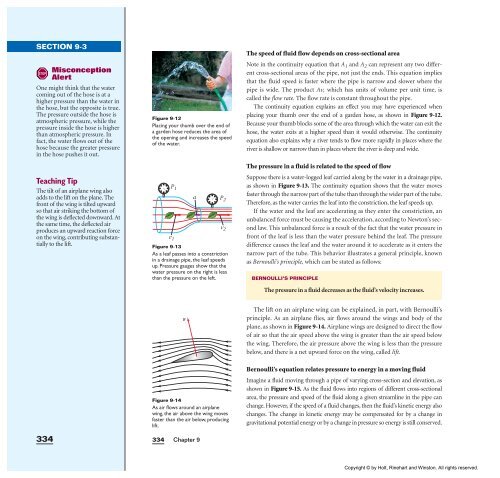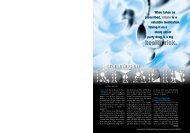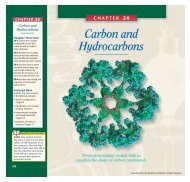Create successful ePaper yourself
Turn your PDF publications into a flip-book with our unique Google optimized e-Paper software.
SECTION 9-3<br />
Misconception<br />
STOP<br />
Alert<br />
One might think that the water<br />
coming out of the hose is at a<br />
higher pressure than the water in<br />
the hose, but the opposite is true.<br />
The pressure outside the hose is<br />
atmospheric pressure, while the<br />
pressure inside the hose is higher<br />
than atmospheric pressure. In<br />
fact, the water flows out of the<br />
hose because the greater pressure<br />
in the hose pushes it out.<br />
Teaching Tip<br />
The tilt of an airplane wing also<br />
adds to the lift on the plane. The<br />
front of the wing is tilted upward<br />
so that air striking the bottom of<br />
the wing is deflected downward. At<br />
the same time, the deflected air<br />
produces an upward reaction force<br />
on the wing, contributing substantially<br />
to the lift.<br />
334<br />
Figure 9-12<br />
Placing your thumb over the end of<br />
a garden hose reduces the area of<br />
the opening and increases the speed<br />
of the water.<br />
334<br />
P 1<br />
v 1<br />
Chapter 9<br />
P 2<br />
v 2<br />
Figure 9-13<br />
As a leaf passes into a constriction<br />
in a drainage pipe, the leaf speeds<br />
up. Pressure gauges show that the<br />
water pressure on the right is less<br />
than the pressure on the left.<br />
F<br />
Figure 9-14<br />
As air flows around an airplane<br />
wing, the air above the wing moves<br />
faster than the air below, producing<br />
lift.<br />
a<br />
The speed of fluid flow depends on cross-sectional area<br />
Note in the continuity equation that A 1 and A 2 can represent any two different<br />
cross-sectional areas of the pipe, not just the ends. This equation implies<br />
that the fluid speed is faster where the pipe is narrow and slower where the<br />
pipe is wide. The product Av, which has units of volume per unit time, is<br />
called the flow rate. The flow rate is constant throughout the pipe.<br />
The continuity equation explains an effect you may have experienced when<br />
placing your thumb over the end of a garden hose, as shown in Figure 9-12.<br />
Because your thumb blocks some of the area through which the water can exit the<br />
hose, the water exits at a higher speed than it would otherwise. The continuity<br />
equation also explains why a river tends to flow more rapidly in places where the<br />
river is shallow or narrow than in places where the river is deep and wide.<br />
The pressure in a fluid is related to the speed of flow<br />
Suppose there is a water-logged leaf carried along by the water in a drainage pipe,<br />
as shown in Figure 9-13. The continuity equation shows that the water moves<br />
faster through the narrow part of the tube than through the wider part of the tube.<br />
Therefore, as the water carries the leaf into the constriction, the leaf speeds up.<br />
If the water and the leaf are accelerating as they enter the constriction, an<br />
unbalanced force must be causing the acceleration, according to Newton’s second<br />
law. This unbalanced force is a result of the fact that the water pressure in<br />
front of the leaf is less than the water pressure behind the leaf. The pressure<br />
difference causes the leaf and the water around it to accelerate as it enters the<br />
narrow part of the tube. This behavior illustrates a general principle, known<br />
as Bernoulli’s principle, which can be stated as follows:<br />
BERNOULLI’S PRINCIPLE<br />
The pressure in a fluid decreases as the fluid’s velocity increases.<br />
The lift on an airplane wing can be explained, in part, <strong>with</strong> Bernoulli’s<br />
principle. As an airplane flies, air flows around the wings and body of the<br />
plane, as shown in Figure 9-14. Airplane wings are designed to direct the flow<br />
of air so that the air speed above the wing is greater than the air speed below<br />
the wing. Therefore, the air pressure above the wing is less than the pressure<br />
below, and there is a net upward force on the wing, called lift.<br />
Bernoulli’s equation relates pressure to energy in a moving fluid<br />
Imagine a fluid moving through a pipe of varying cross-section and elevation, as<br />
shown in Figure 9-15. As the fluid flows into regions of different cross-sectional<br />
area, the pressure and speed of the fluid along a given streamline in the pipe can<br />
change. However, if the speed of a fluid changes, then the fluid’s kinetic energy also<br />
changes. The change in kinetic energy may be compensated for by a change in<br />
gravitational potential energy or by a change in pressure so energy is still conserved.<br />
Copyright © by Holt, Rinehart and Winston. All rights reserved.
















